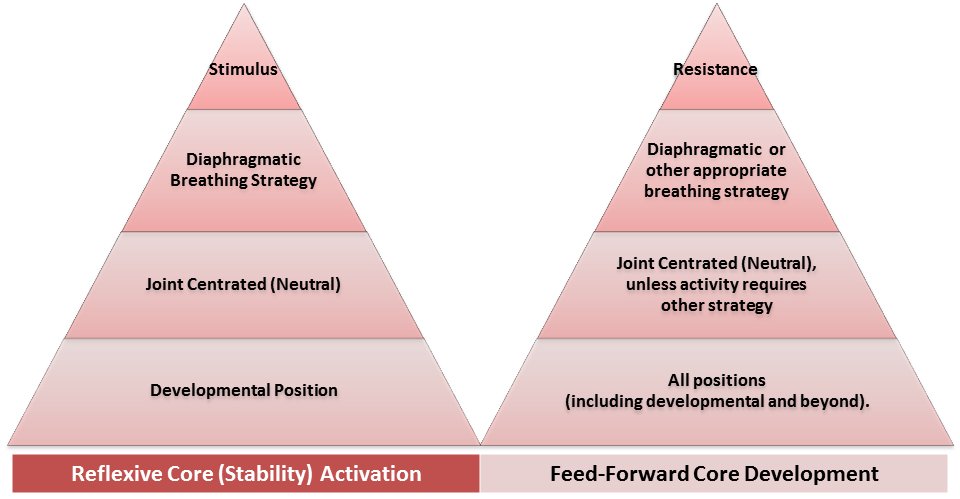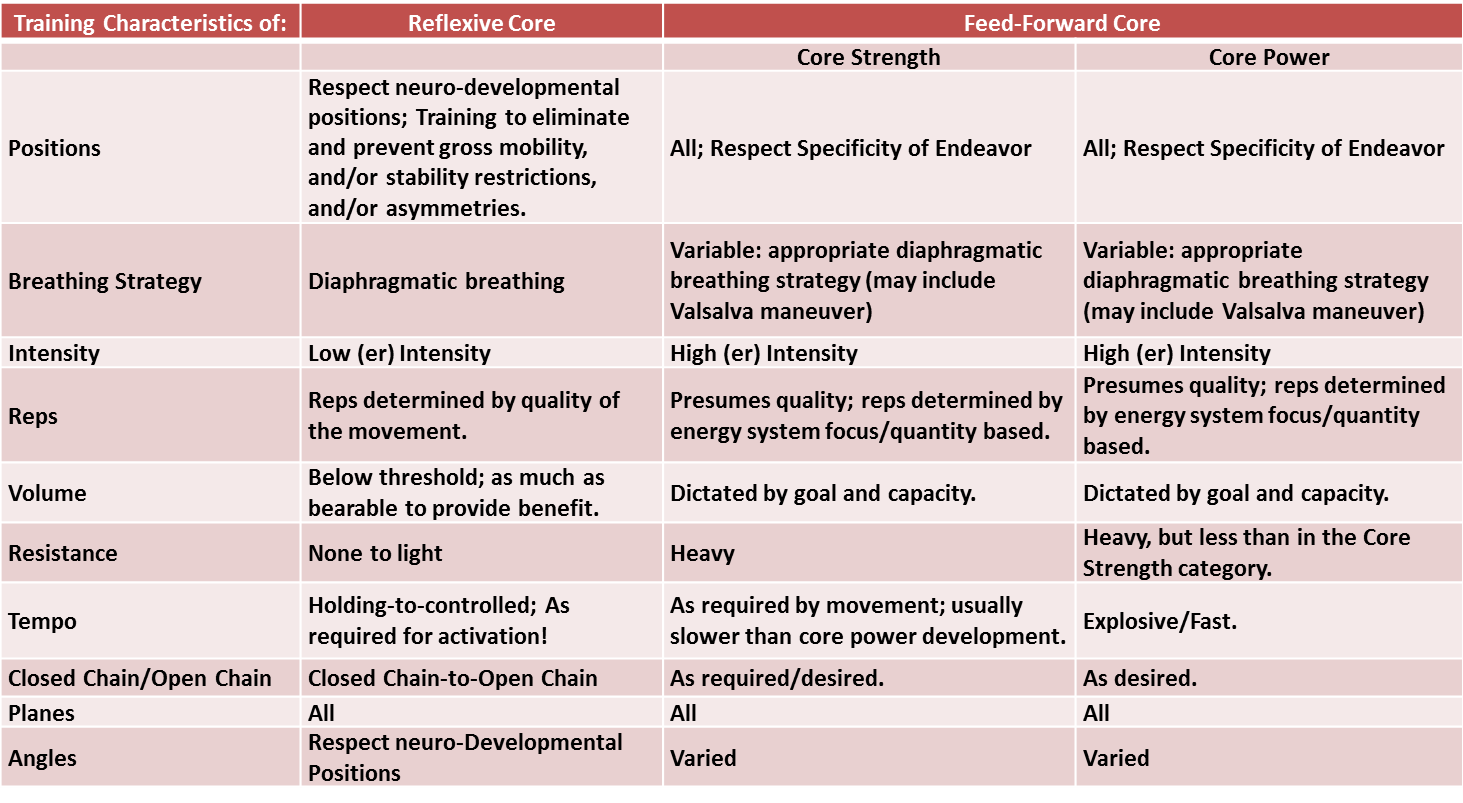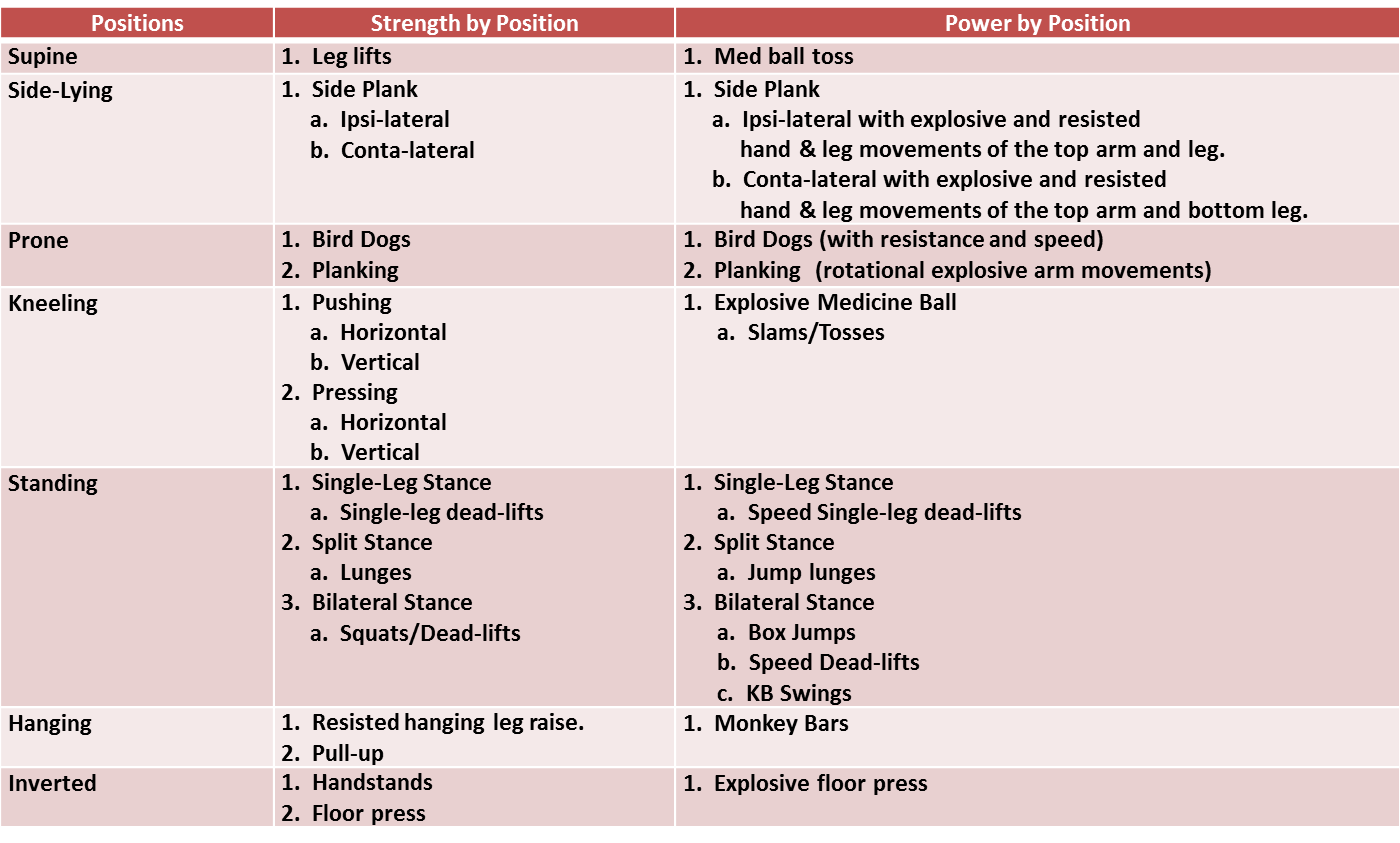Why Move Well Week 1
Posted by Gray Cook
During the two-and-half decades that I have been involved in fitness, the definition of "the core" and consequently, core training has evolved. Part of the evolution is subjective (meaning I have learned more about the topic) and part is objective (as a profession there is more and better information about the subject area). With so many great minds in the rehab and fitness arena contributing daily in the information age, a good deal of terrific data exists about the "the core". In Part 1 of this article I attempted to define what makes-up the core and its functions. In this article I will suggest an approach to core training.
III. Approach to Training the Core

A. Reflexive Core (Stability) Activation Approach
Reflexive Core Stability is the precursor to optimal core strength and power development. Reflexive core training is also known as motor control (stability), and core strength and power training is also known as "feed-forward". Understanding whether or not a reflexive core stability deficiency exists is the first step. Using the Functional Movement Screen (FMS) or the Selective Functional Movement Assessment (SFMA) to examine whether or not a client has reflexive core instability is one effective approach. If so, the client must address this fault in the appropriate developmental position, with joints centered (neutral), while maintaining diaphragmatic breathing, while using appropriate stimulus to activate the inner core, before considering any feed-forward core training.
a. Developmental Positions
One of Gray Cook's strongest attributes is his ability to take very complex ideas, simplify them and articulate them to many others. Cook's simplification of the human neuro-developmental process is one example. While there are many levels and stages of development, Cook narrowed the process to four main positions: supine (face-up), prone (face-down), kneeling and standing. Within those four positions, there are variations. For example, kneeling can be balanced on one or two knees. The key is to establish a strong level of reflexive core (stability) in each of the four main developmental positions, as well as transitional positions (i.e., rolling from supine to prone), prior to progressing to strength and power development. At a minimum, it is imperative that the client own reflexive core stability in the position you intend to train. In other words, training a loaded squat with a client that has inadequate reflexive core stability in a body-weight squat is, at best, counterproductive and, at worst, dangerous.
b. Joint Centration and Diaphragmatic Breathing
Once a developmental position has been determined and joint centered position assumed, proper breathing is necessary in order to activate the spine's inner core, which is imperative for proper reflexive core stability. This approach helps to maintain the centering and stabilization of all loaded joints and enables the execution of a movement pattern. Because breath is the foundation of the core (and many other things), it is important to determine whether or not a person can breathe properly. I know this sounds simple, but it never ceases to amaze me how difficult diaphragmatic breathing is for many. Individuals may be able to maintain diaphragmatic breathing in a lower developmental position (i.e. laying on their back), but not in a higher developmental position (i.e., standing) or vice-versa. Furthermore, breathing can also be disrupted by making an activity more challenging/strenuous (i.e. training a higher developmental position; or training a body weight squat versus a weighted squat). Therefore, training in a position where breath cannot be maintained is counter-productive!
There are many techniques to assess breathing as well as many techniques to coach the reestablishment of proper breath. While that subject is worthy of much greater analysis, I will try to summarize it here. When we coach breathing (specifically with respect to reflexive core) training at Advanced Wellness, we first help the client achieve a joint neutral position. We then ask the client to imagine a deflated balloon inside their trunk, with their nose being the opening of the balloon. While drawing air in through their nose, we ask the client to direct (focus) their breath to their pelvic floor, the bottom of the balloon. Once the inhaled air hits the pelvic floor, we coach having the breath expand in all 360˚ as it travels up the sides of the balloon on its way back to the opening. With the balloon fully inflated, we ask the client to keep the balloon inflated (eccentrically contracted) while maintaining their breath. With every subsequent repetition, the goal is to expand the balloon a tiny bit more, yet do so in a relaxed fashion. Once breathing is proficient in that position, you have re-established the first function of the inner core: respiration in that developmental position.
Diaphragmatic Breathing:
In sum, reflexive core activation is done by assuming any developmental position with joints centered, while maintaining diaphragmatic breathing with or without an outside stimulus or a part of the body creating a perturbation. In addition to the video above, another example would be the half-kneeling hold, or the chop and lift.
Assuming that an adequate level of reflexive core function exists, feed-forward core training is appropriate. One way to delineate reflexive core training from feed-forward core is that reflexive core training focuses on the things you are not able to do, while core strength and power is about how much load, how many reps and sets (volume) one can handle. When the focus changes to feed-forward core training, the positions expand beyond the developmental positions (i.e. pull-ups). Furthermore, breathing strategies evolve beyond continuous diaphragmatic breathing, to whatever strategy is effective for the activity (see valsalva maneuver, a different form of diaphragmatic breathing). Resistance and intensity also increases. Moreover, I believe good quality movement-based feed-forward core training will, in most cases, continue to support good activation of the inner core. However, the reverse is not necessarily true: good reflexive core training will only enhance feed-forward core strength and power output in those that lack inner core activation. In short, the approach is to first activate the inner core, and then develop feed-forward core strength and/or power as appropriate.
The table below outlines the characteristics that distinguish reflexive core training from feed-forward core training, and furthermore, the difference in feed-forward strength and power development training.

It should be noted that excessive or inappropriate feed-forward core training can disrupt the balance between the inner and outer core, causing the central nervous system to rely on the bigger muscles of the outer core. This is one example of what is known in the FMS community as "putting fitness on top of dysfunction." It is theorized that this can lead to undue compressive forces on the spine, over-use injuries and should obviously be avoided.
c. Reflexive Core Training Example
Here is an example of how you train your core reflexively in the supine position: start by laying on your back with feet elevated, knees bent to 90˚ and externally rotated (turned-out); hands above the shoulders with palms-up to the ceiling and elbows off the ground. Rotate your bottom two ribs (right underneath your chest) down towards feet and floor, gently externally rotate the shoulders, while pulling the elbows away from your body; finally, try to press your chin to the back of your neck, flattening your spine. Once in the supine developmental position, see if you can maintain diaphragmatic breathing as described previously in this article. If not, practice this. Once you have this down, begin by adding single limb body movements: Extending one leg away from the body, one arm above your head, mixing ipsilateral and/or contralateral limb simultaneous flexion or extension, or synchronizing leg flexing with arm extending. This must be done while you maintain the original starting (neutral position) and diaphragmatic breathing. This is one example of reflexive core training in the supine position.
Supine Reflexive Core Training:
Once motor control proficiency is established in this activity, adding resistance, by way of a weighted stability ball, for instance, is appropriate for feed-forward core strength and power development.
B. Feed-forward Core Development Approach and Example Exercise
Other examples of feed-forward core training include:

Training patterns beyond development (i.e. handstand), adding resistance, increasing volume (working towards a specific rep count and number of sets) or tempo (speed), while using breath cycles appropriate for the activity, qualifies as feed-forward core training. The videos below illustrate feed-forward core strength and feed-forward core power development.
Feed-Forward Core Strength:
Feed-Forward Core Power:
C. Attacking Core Training: Where to Start?
Here is the step-by-step approach to core training in 2014:
1. Determine if a reflexive core deficiency exists? Use FMS or SFMA (or whatever tool you have to make that determination).
2. If the reflexive core is not functioning properly, select the appropriate developmental position with centered joints, use diaphragmatic breathing and add the appropriate stimulus to retrain the reflexive core.
3. If the reflexive core properly activates, move on to feed-forward core training. Use positional variety including and extending beyond the four main developmental positions, while maintaining joint centration, appropriate breathing strategies, adding resistance, intensity and volume (as dictated by the training goal) to develop feed-forward core strength and power.
4. As a maintenance/prehab measure, continue to recheck reflexive core function on a regular basis (see FMS & SFMA). At Advanced Wellness, we program corrective based reflexive core activation drills into pre-workout warm-up, mid-workout and post-workout-cool-down for every client; as well as rescreen our clients on monthly basis.
Core training is, in essence, part of everything we do: every position and every movement. So yes, core training includes doing sit-ups just like the PPFT in the 1980's. Doing crunches like my friend used to do--to no end-- is also core training. I am speculating here, but I believe it is likely that he had to give up his athletic career due to back pain because his inner core never functioned properly after a high school knee injury. Therefore, making sure that your core is functioning and training in a way that promotes good core function (both reflexive and feed forward) is core training in 2014. It will be interesting to see how this subject evolves in the future.
For more information about Leo Shveyd and Advanced Wellness, please visit http://www.advancedwellness.com.
Posted by Gray Cook
Posted by Lee Burton
Hit the jackpot! Thanks.
For those of us who have has radical prostatectomy core training is important. The kegel being the main and sometimes only exercise used.
I have a good therapist but there is still something lacking or I am doing something wrong.
There is a ton of information about women and for women on incontinence while only some information is aimed at men.
My question is there any routine or exercise sequence that can better aim at the problems associated recovery from prostate surgery.
There are a lot of men in my position and I believe there will be a lot more in the near future. Diagnosis is advancing faster than treatment options.